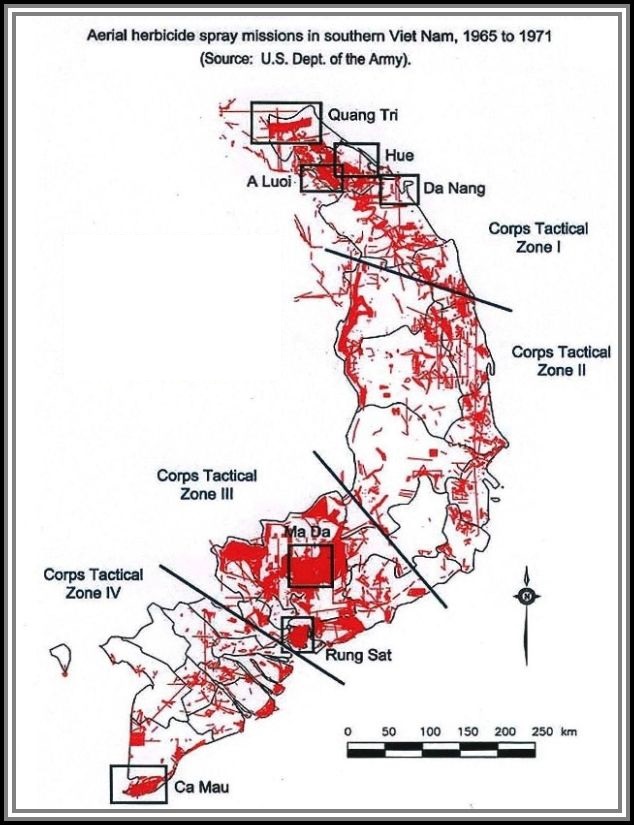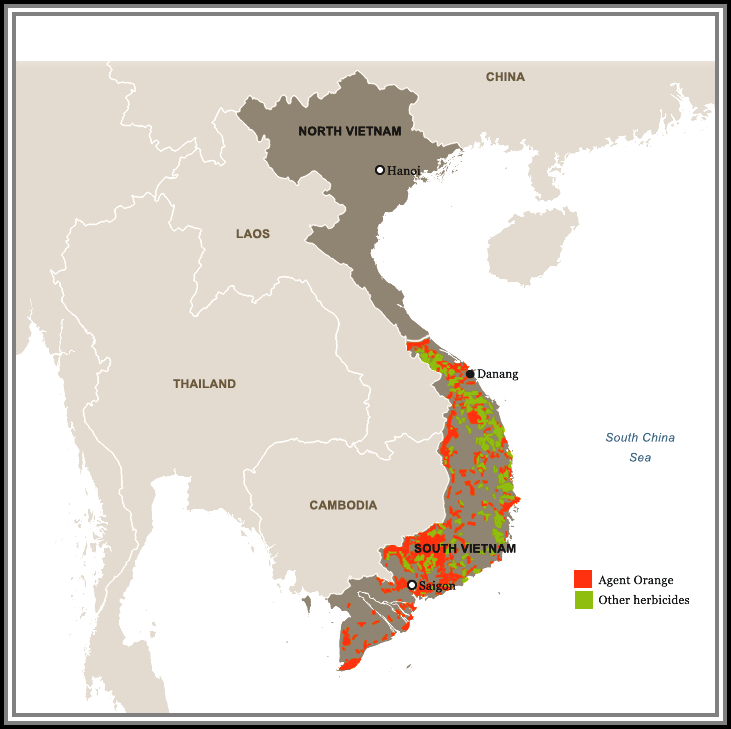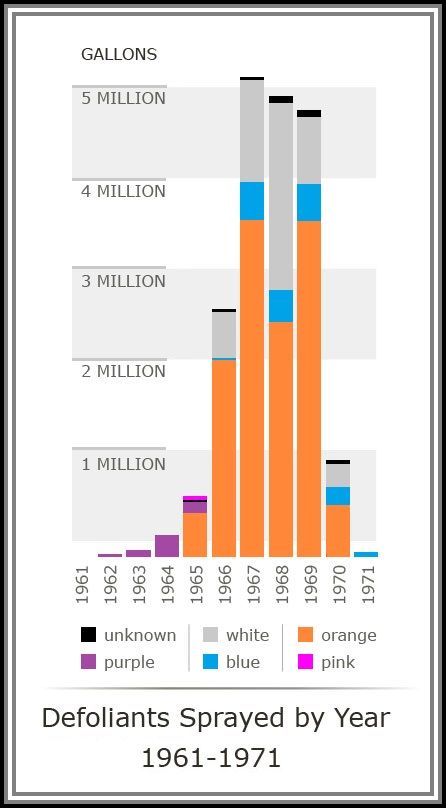SECTION 9. CONTENTS
Herbicide Spray Missions 1965-1971
SECTION 9.
LEGEND
Approximate boundaries of
U. S. Corps Tactical Zones
Spray missions
Privincial boundaries
Areas examined during the
A Luoi dioxin and RADARSAT
programs 1994 - 1996
Herbicide Spraying During the Vietnam War
| ||||
| ||||
| ||||
| ||||
| ||||
|
From 1961 to 1971 (as shown in the Chicago Tribune chart, above), the US government sprayed some 20 million gallons of herbicides and defoliants over vast areas of South Vietnam (and to a lesser extent in Laos, Cambodia, and even, marginally, North Vietnam), in “Operation Trail Dust.” Some 95% of the herbicides were sprayed by the US Air Force flying C-123s as part of “Operation Ranch Hand.” Fitted with specially developed spray tanks with a capacity of 1000 gallons of herbicide, the planes typically sprayed a 14 kilometer (8.5 mile) swath of land in about 4 ½ minutes. The remaining 5% were sprayed by backpacks, hand, helicopters and trucks around US military installations by the US Army Chemical Corps and allied forces. The herbicides sprayed were up to 50 times the concentration that would have been used for normal agricultural use.
[Source: Agent Orange Record. © 2010 Agent Orange Record. All photos property of their rightful owners. Agent Orange Record is an undertaking of the War Legacies Project, a not-for-profit organization.]
Agent Orange was a powerful mixture of chemical defoliants used by U.S. military forces during the Vietnam War to eliminate forest cover for North Vietnamese and Viet Cong troops, as well as crops that might be used to feed them. The U.S. program of defoliation, codenamed Operation Ranch Hand, sprayed more than 19 million gallons of herbicides over 4.5 million acres of land in Vietnam from 1961 to 1972. Agent Orange, which contained the chemical dioxin, was the most commonly used of the herbicide mixtures, and the most effective. It was later revealed to cause serious health issues–including tumors, birth defects, rashes, psychological symptoms and cancer–among returning U.S. servicemen and their families as well as among the Vietnamese population.
OPERATION RANCH HAND AND AGENT ORANGE
From 1961 to 1972, the U.S. military conducted a large-scale defoliation program aimed at destroying the forest and jungle cover used by enemy North Vietnamese and Viet Cong troops fighting against U.S. and South Vietnamese forces in the Vietnam War. U.S. aircraft were deployed to spray powerful mixtures of herbicides around roads, rivers, canals and military bases, as well as on crops that might be used to supply enemy troops. During this process, crops and water sources used by the non-combatant peasant population of South Vietnam could also be hit. In all, Operation Ranch Hand deployed more than 19 million gallons of herbicides over 4.5 million acres of land.
The most commonly used, and most effective, mixture of herbicides used was Agent Orange, named for the orange stripe painted on the 55-gallon drums in which the mixture was stored. It was one of several “Rainbow Herbicides” used, along with Agents White, Purple, Pink, Green and Blue. U.S. planes sprayed some 11 million to 13 million gallons of Agent Orange in Vietnam between January 1965 and April 1970. According to the U.S. Department of Veterans Affairs (VA), Agent Orange contained “minute traces” of 2,3,7,8-tetrachlorodibenzo-p-dioxin (TCDD), more commonly known as dioxin. Through studies done on laboratory animals, dioxin has been shown to be highly toxic even in minute doses; human exposure to the chemical could be associated with serious health issues such as muscular dysfunction, inflammation, birth defects, nervous system disorders and even the development of various cancers.
The controversy over Agent Orange and its effects has persisted for more than four decades. As late as June 2011, debate continued over whether so-called "Blue Water Navy" veterans (those who served aboard deep-sea vessels during the Vietnam War) should receive the same Agent Orange-related benefits as other veterans who served on the ground or on inland waterways.
©2012 A&E Televisions Networks, LLC.--All Rights Reserved.
DISCLAIMER: This presentation is offered for general information purposes only. It does not constitute specific legal advice. You should not act or rely upon any of the information contained herein without the guidance and advice of an accredited Veterans Service Officer.


